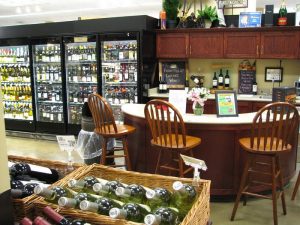Whole Foods’ brown paper shopping bags now contain the message, written large on the side, “I just got more of the good stuff for less.” The specialty grocery chain has long been known for “the good stuff.” It’s the “for less” part of the message that tells the story of today’s food retailing dynamic. “Everyone’s looking to save money,” says Ken Pray, director of store design for The Kroger Co. (Cincinnati).
The popular wisdom is that, in the current economy, food retailers will do better than others because people have to eat. And as consumers cut down their restaurant visits, food retailers get an even bigger slice of the pie. But competition for that slice is intense, and specific marketing messages will be important.
However, cautions Edward Parker, director of sales and marketing for the Design Services Group (DSG, Eden Prairie, Minn.), retailers can’t just switch overnight to a completely price-oriented strategy. “Then they’re battling Walmart,” he says. “And you can’t beat Walmart on price.”
Grocers don’t want to abandon quality, either, as more consumers are focused on staying healthy to combat the worry and cost of healthcare.
So there are multiple messages food retailers will have to convey, and the stores will be essential conveyors of those messages: convenience, speed, efficiency, quality, service, variety, health and freshness, as well as price.
Get in and Get Out
Some retailers are testing smaller formats that, at 15,000 to 20,000 square feet (or even smaller), are less than half the size of traditional supermarkets. It’s an attempt to fill the need of time-starved shoppers who want to buy basics and get in and out quickly.
Advertisement
“I call it the spoke-and-hub system,” says Parker, whose design firm is a subsidiary of Supervalu Inc. (Eden Prairie, Minn.) but also designs stores for regional operators like Pine Hills Market in Massachusetts, Ukrops in Virginia and Dahl’s in Iowa. “They have their big stores in the middle of the hub, where shoppers go to fill up their pantries. And they have the smaller fill-in stores throughout the area where shoppers go for their daily needs.”
Get in and Indulge
The same retailers are also testing larger, fancier stores. Kroger has been rolling out its Fresh Fare concept in various markets at roughly 70,000 square feet.
“It’s for an upscale shopper with higher expectations,” says Kroger’s Pray. “It has gourmet products and special service areas.” For example, the deli department is branded as a Boar’s Head shop within the store and Murray’s Cheese – a gourmet purveyor out of New York – operates the cheese department.
Pray explains that the bakery department has specialty pastries and cakes in a case, as well as a broad selection of breads and packaged desserts on nearby shelves for self service. “And we’re doing more sampling,” he adds.
How does Kroger justify these higher-level stores in the face of a sagging economy? “It diversifies our portfolio,” Pray says. “It’s an upscale brand, which – along with our standard Kroger format, larger Marketplace format, smaller value format and Hispanic format – allows us to offer something for every demographic.”
Concrete, Skylights and LEDs
Bigger or smaller, higher-end or sparse, there are many ways store designers are adding cost-savings to their buildings that also enhance their messages, like switching from tile floors to dyed and stained concrete. “It’s less expensive,” Parker says, “and still looks attractive and rustic.” Similarly, skylights, larger windows and more use of LEDs not only augment the look and feel of the store but also save money – as well as the planet.
Advertisement
And there is an increased emphasis on visual merchandising. Whole Foods perfected the idea that presentations – such as color-coordinated stacks of peppers and fruit – will convince shoppers there’s quality to be had. And as service becomes a more important ingredient, clear and eye-catching wayfinding signage will be a critical component.
Home Meal Replacement, a phenomenon that took hold in the 1990s for empty-nesters and dual-income households seeking quality and efficiency at the same time, is still thriving. It led to higher-end corners of the store where quality materials and softer lighting showcased prepared gourmet foods. Since shoppers are eating at home more, they’re still seeking ready-to-go meals, but also quality, individual components for home-cooked meals.
“People are buying more sauces, seasonings, deli items, produce and specialty breads,” Parker says. “These items may be a bit more expensive than those on the shelves, but if the shopper feels she’s spending less here than in a restaurant for quality goods, she has bought into the all-important value proposition.”
After all, Parker says, “food is what shoppers put in their mouths and the mouths of their children. Even as they’re seeking to save money, they’ll never abandon the desire for freshness and quality.”


 Headlines2 weeks ago
Headlines2 weeks ago
 Headlines1 week ago
Headlines1 week ago
 Headlines1 week ago
Headlines1 week ago
 Headlines4 days ago
Headlines4 days ago
 Headlines7 days ago
Headlines7 days ago
 Designer Dozen1 week ago
Designer Dozen1 week ago
 Designer Dozen1 week ago
Designer Dozen1 week ago
























